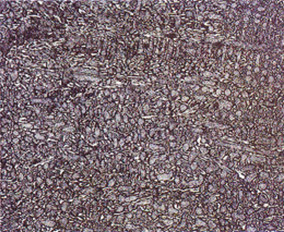The result of metallographic analysis of composite weld overlay plates
Below are the results of metallographic analysis with an assessment of the microstructure of the deposited layer with different contents of Cr and C:

Sample No.1 – chromium content – 16,70%, carbon content– 2,88%
- C2.88%
- Cr16,70%
- Mn2,03%
- B0,5%
The alloy does not contain visible chromium carbides, most of the chromium content is visible in the matrix as white spots.
Rockwell hardness is 51.37 HRC

Sample No.2 – chromium content – 26,40%, carbon content– 3,88%
- C3,88%
- Cr26,40%
- Mn2,55%
- B0,5%
The increase in chromium and carbon results in the formation of primary chromium carbides, which can be seen as light hexagonal shapes.
Rockwell hardness is 55.8 HRC

Sample No.3 – chromium content – 29,20%, carbon content – 4,33%
- C4,33%
- Cr29,20%
- Mn3,22%
- B0,5%
The increase in chromium and carbon results in the formation of primary chromium carbides, which can be seen as light hexagonal shapes.
Rockwell hardness 57,6 HRC

Sample No.3 – chromium content – 32,60%, carbon content – 4,84%
- C4,84%
- Cr32,60%
- Mn3,34%
- B0,5%
The increase in chromium and carbon results in the formation of primary chromium carbides, which can be seen as light hexagonal shapes.
Rockwell hardness 57,8 HRC
Metallographic analysis with an assessment of the microstructure of the deposited layer of 4 different samples featuring different contents of chromium and carbon showed the following result:
- The morphology of carbide inclusions, their crystal structure, sizes, quantitative ratio, distribution features in the matrix, despite the high level of hardness, have a significant impact on the level of wear resistance of materials.
- Judging of operational characteristics only considering hardness according to the Rockwell method, without taking into account the structure, is unlikely to provide an objective assessment of the wear resistance of the welded layer.
- The hardening effect was most pronounced with an increase in the chromium content to at least 30% and carbon to more than 4%. This composition has maximum wear resistance.
Thus, with a chromium content of more than 30% and carbon of more than 4%, the weld overlay has the best performance characteristics when exposed to abrasive particles on the material.
WEARTECH wear-resistant composite weld overlay plates have a chromium content of 32-37% and carbon of 4.5-5% with evenly distributed and strictly oriented high-strength carbides in a plastic austenitic matrix, which makes it possible to achieve the highest wear resistance of the protected surface.
We aim at developing the best wear protection solutions